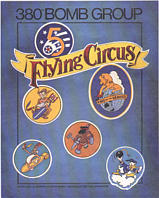
 |
380th Bomb
Group Association
|
On first appearance the most distinctive feature between any two B-24s is the type of armament protection of the nose of the aircraft. This is reflected in the appearance of the successive models of the B-24 and their variants as WWII progressed.
This will be the basis for our separation of the aircraft used by the 380th Bomb Group into models or types. Our grouping will closely follow that presented in Issue 41 of THE FLYING CIRCUS Newsletter of the 380th Bombardment Group (H) Association, Inc., dated March 1991, by Glenn Horton.
The several separate groupings (Types) are as follows:
1. The so-called "Greenhouse" nosed B-24D with only manually-operated machine guns as nose protection. All of the Initial Deployment aircraft of the 380th Bomb Group were of this type.
2. Modification of an original "Greenhouse" nosed B-24D to carry a Consolidated A6A tail turret in the nose. In the case of the 380th, these were all theatre modifications carried out at the Townsville, Australia, Depot. Some of our original planes were so modified, but all replacement aircraft received after August 1943 carried such armament. These were called Hawaii noses to distinguish them from Type 3, which were called Oklahoma noses.
3. In addition to theatre modifications, i.e., Townsville, there was a stateside effort to supply a few such modifications before going overseas. These were carried out at the Oklahoma City Depot and were distinctively different from Type 2.
4. The initial B-24J models, which had the A6A nose turret installed at the factory.
5. B-24Js with the A6A turret replaced by the A6B, which was lighter and could be more easily streamlined into the fuselage.
6. B-24Js with the horn type pitot tubes of the earlier models replaced by a pitot tube placed low on the left side of the nose.
7. Type 6 B-24Js with a small window installed behind the bombardier's window on each side to increase visibility for the bombardier.
8. Replacement of the A6B Consolidated turret with the Emerson A-15 electric turret. The Consolidated turrets were all hydraulically operated. All subsequent models used the Emerson turret for the nose protection.
9. B-24M aircraft by Consolidated. Very similar in appearance to Type 8. However, these aircraft carried newer radar and other equipment. (There was also a Consolidated B-24L but the 380th did not receive any; one was borrowed for a short period from the 90th Bomb Group.)
10.-12. B-24s manufactured by the Ford Motor Company at Willow Run, Michigan. These differed from the aircraft of Consolidated by having a large "balcony" window in each side of the nose to increase visibility.
10. B-24L-FO. In addition to the above, this design featured a lightweight tail station with gun movement hydraulic boost but no full turret.
11. B-24M-FO. Returned to the tail turret but had increased electronic features of B-24M-CO.
12. B-24M-FO with a V-shaped (2-piece) pilots windshield to increase pilot visibility.
This division of the B-24 into sub-types has formed the basis of the organization of this book since the appearance of the aircraft was chronological with the serial numbers of the aircraft themselves. A further discussion of the distinctive between types will introduce each section of this book in turn.
Go to Aircraft Types Go to Aircraft Listing
Go to Part V Planes (for the aircraft used in the Australia/New Guinea Campaign) Go to Part V Introduction
Go to Part VI Planes (for the aircraft used in The Philippines Campaign) Go to Part VI Introduction